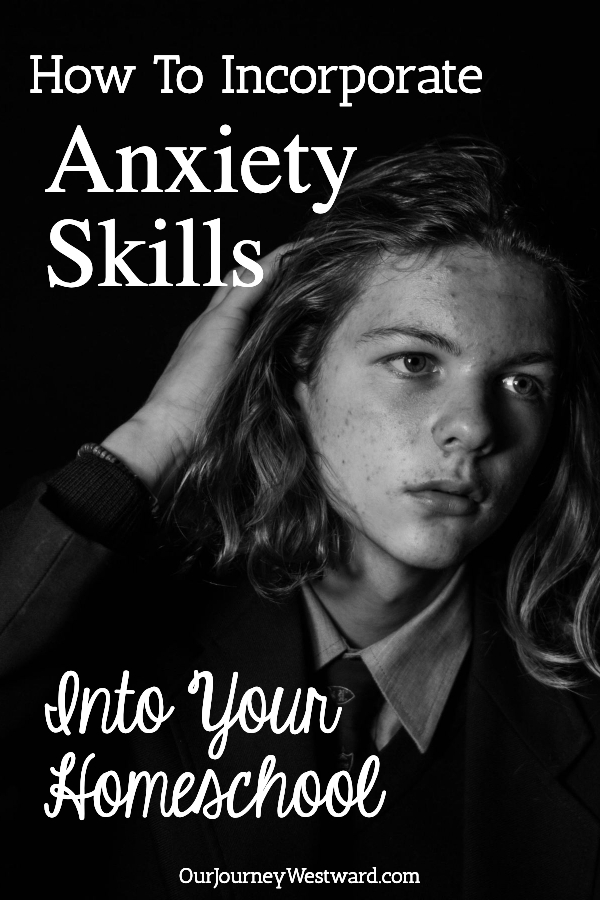How To Incorporate Anxiety Skills Into Your Homeschool
This guest post, written by my friend Jen Vail, is a treasure to help you deal with homeschool anxiety skills. Be sure to bookmark it or pin it to come back time and time again for ideas and reassurance.
When I was much younger and not so dependent upon ibuprofen, I had a lot of plans. Fame and fortune, obviously, the admiration of Prince William, and all of the Rocky Mountain jeans I could imagine.
Homeschooling was never in my plans, nor was the severe anxiety disorder one of my children would be diagnosed with. Fortunately I have carried with me a lifelong desire to help, and long before my children were born I earned my training and degree in counseling, with a specific expertise in anxiety.
If you know me at all or have ever read my writing elsewhere, you’re aware that I, too, struggle daily with anxiety. Between my training, my kids, and myself, I think about anxiety more in a day than I do quicksand or the Bermuda Triangle, which is not at all how childhood me thought adult me would turn out.
Much of my life’s work, to this point, is devoted to working through anxiety, be it my own or my child’s. Because we homeschool and spend so much time together, we have the opportunity to work in several tools throughout the week to help strengthen anxiety skills and empower anxious kiddos, some of which I’ll share today.

This post contains affiliate links.
Homeschool Anxiety Skills
It’s important to note that children – all people, really – who struggle with mental health issues should be seen by a licensed and experienced therapist. Everything that I share here is incorporated and intended as supplemental to therapy, as long as it is not contraindicated. The skills and tools discussed are never meant to replace therapy, but are shared in the hopes of helping you and your child work through difficult moments at home.
Help Your Child Understand What They’re Feeling
One of the most prevalent struggles facing children today is anxiety. People of all ages are beginning to share honestly about their feelings of fear, panic, overwhelm, and dread. One of the main hurdles of battling childhood anxiety, however, is that children lack the vocabulary to identify what they’re feeling as anxiety. I like to say that kids’ emotions are like primary colors, but we as adults know that emotions are a full spectrum and rainbow of colors, varying in shades and intensity.
When a child feels an emotion, they typically can only define it as “anger”, “fear”, “happiness”, or “sadness”. You’ll see this when a child becomes embarrassed and lashes out in anger, because they simply don’t know what else to do with the feeling. Anxiety, in the truest form, is not simply being afraid of something, it is a fight-or-flight response that the body experiences, sometimes with no real trigger. Imagine how confusing such an intense reaction must be to a child who has no way to communicate the experience, let alone understand what caused it.
In homeschooling, anxiety can present as anger, frustration, or perfectionism. Sensory overwhelm can cause a child to become on-edge or emotional. Whenever you sense or notice your child becoming overwhelmed or aggravated, have them stop. Encourage your kiddo to take notice of what they’re feeling at that moment – Are they hungry? Are they hot? Is their stomach upset? Do they feel mad? Do they feel rushed? What makes them feel this way? What do they think would make them feel differently? Encourage discussion and help your child to identify what they’re feeling, emotionally and physically, to build their understanding of just what’s going on in their body. Studies have shown that simply being able to name the emotion being felt lessens the power it has over the body.
Empower your child by helping them understand what their body is experiencing. Assure them that they are not in danger, nothing bad is happening, there is no rush. Anxiety is a chemical rush that the brain creates that causes a chain reaction of symptoms throughout the body. Take the time to explore these symptoms – the increased heart rate, the flushed cheeks, the churning tummy. Anything you can do to normalize the symptoms will remind your child that there’s nothing to run from when their body suddenly goes into fight-or-flight mode.
The Worst-Case Scenario Anxiety Tool
One of my favorite and most often used tools is the worst-case scenario tool. Anxiety is not a logical beast and will often have sufferers creating the most imaginative scenarios that seem entirely possible. Rather than brush off the “what ifs” or offering blanket reassurances, which is almost always the impulse when faced with an improbable scenario, embrace it. Go with it.
A common trigger in our homeschool is math and the frustration that erupts from not understanding formulas or concepts. My anxious child can go from “incorrect” to “I’m failing at life” in a split second. Rather than roll my eyes or telling them to calm down (by the way, telling an anxious person in the midst of their anxiety to “calm down” never, ever works), I ask, “If you get this wrong, what is the worst thing that can happen?” They answer, usually with some doomsday scenario. Follow that one through. “Okay, then what happens?” You continue this questioning until you’ve reached the conclusion, which is almost never as catastrophic as the child first thinks. “If I get it wrong, I might fail.” “Okay, and if you fail, then what?” “I have to take it again.” “Then what’s the worst thing that happens if you have to take it again?” “I don’t know, I guess I just take more math.”
Seeing a “threat” through to its logical and survivable ending is an incredibly calming tool that can help your child down the road in just about any circumstance. “I’m afraid of being humiliated.” “Okay, and if you are, what is the worst possible thing that could happen?” Fears are often so much larger than the actual possible outcomes, and breaking them down into a flowchart of sorts helps them become digestible, manageable, fallible. Especially when remembering that kids often lack the ability to dictate what they’re experiencing, and how enormous teenage fears and emotions can be, anything that can be done to help them minimize and grasp what seems so overwhelming is both calming and empowering.
Open-Ended Talk and Play for Anxiety
Anxious children, while often incredibly creative, can also be incredibly inflexible in their thinking. Their bodies are telling them they are in danger, so it is difficult to convince them otherwise. It’s very important to introduce them to various perspectives, to the idea that different ideas can be correct, and that not everything we think is true. One of the best ways to do this in your homeschool is through open-ended discussion and games.
Philosophy is a fantastic subject to introduce, allowing both for multiple perspectives, varied discussions, and no real right or wrong conclusions. There are philosophy texts for all ages that can present ideas and circumstances to discuss and consider at great length, thoughts to challenge your child’s way of thinking and prove that life, thought, and reactions are far more flexible than they may have once thought.
Art is another great topic that is almost entirely subjective. Flip through an art history book or wander the hushed halls of a museum and discuss how pieces make you feel, what you like, what you don’t like, what you notice the most, and more. Any kind of discussion that encourages sharing differing (and respectful) opinions that don’t defeat one another is a wonderful way to grow flexible thinking in anxious children. And who doesn’t like looking at art?!
Sometimes competitive or strategic games can be too triggering for anxious kids who feel the pressure to perform or win. Open-ended games that focus more on fun or creativity can serve both to distract or calm an anxious child or to open up a dialogue about a difficult topic. One of the favorites in our home is Oui Si, a game that encourages players to find connections between images. We also love to play a game where one player draws a squiggle or shape on a sheet of paper and the other has to turn it into an actual picture, a great example of how two perspectives of the same thing can differ.
Playing Boggle for no points is another way to see what is caught – or missed! – by others. Encourage the appreciation of differing perspectives and point out how none are really wrong, then suavely mention how often times we can get so caught up in how we think or feel about a situation that we can forget there are other ways to see it.
Homeschool Anxiety Skills Help So Much
Supporting a child with anxiety is a lifestyle change, truly. Too often parents aren’t told that the weeks at home in between therapy appointments are as important and impactful as the work done in the therapist’s office, and struggling kids have a hard time making changes in an environment that remains the same. Anything we can do as parents to better understand their struggles, to help them, to empower them, is worth the extra time and effort.
I know that adding in an open-ended discussion of philosophy throws a wrench into your homeschool schedule. I know that stopping to Google the symptoms of an anxiety attack in the middle of a math lesson can, in turn, make you feel anxious and rushed. But it is important to remember that anxiety is not an ear infection that can be treated for a week and then forgotten. Your understanding and flexibility will be just as important as your child’s, so to truly see their suffering lessened you’ll need to be committed to making multiple changes.
There are hundreds of homeschool anxiety skills, tools, games, and puzzles that you can keep in your back pocket to help your child through their struggles with anxiety. The most important thing you can offer them, however, regardless of age, severity, frequency of therapy, or family history, will always be your absolute loving support.

Jennifer Vail lives in the great state of Texas with her smokin’ hot husband and 3 precious poppies. She spends her days learning about gifted children, trying her best to meet their needs, and wishing for naps and TV marathons. You can read more of her thoughts at JenniferLikesToBlog.
Other Posts You Might Like













